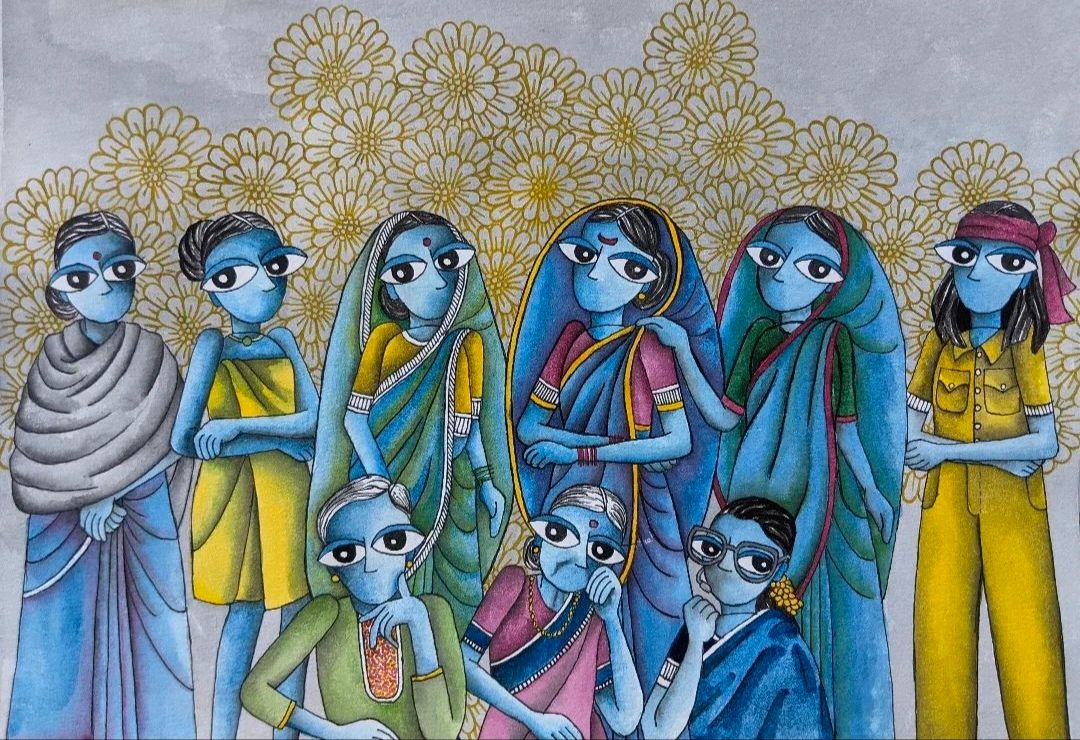Transcending trauma: Dalit women turn to art as a medium for healing
Dalit women often find themselves at the end of triple-fold oppression—of gender, caste and class. As artists, they find a safe space to express and recover from generational trauma through eclectic forms of art—both as resistance and an expression of empowerment.
A lot of the life artist Malvika Raj has lived isn’t seen on canvas. Core memories of her father, a police official, recounting losing a good posting to a colleague belonging to a dominant caste, or putting his job on the line to save Dalit families from getting falsely implicated in crimes, find no impressions.
Neither does her angst as a 12-year-old, who realised that her classmates stopped sharing lunch with her after learning the caste she was born into, and or how her lunchmate—a child from a fisher family—became her only friend at school.
Instead, the Patna-based artist uses her deeply stirring and meditative take on Madhubani art to agitate, as well as celebrate her road to freedom by illustrating every historic visionary, activist, and philosopher who spurred her to tread with dignity through years of discrimination.

Buddha is central to the work of artist Malvika Raj of Patna
Raj subverts the Hindu mythological storytelling tradition of Bihar’s Madhubani art form with Godna-style paintings of Babasaheb Ambedkar, Savitribai Phule, and Phoolan Devi’s life stories.
“And of course, the Buddha,” she tells SocialStory. “The first few paintings I made just after learning the Madhubani art form were traditional tales of Rama and Krishna. But, just like how my father never spoke about his ordeals without ending them with some generous dose of Ambedkarite wisdom, I decided to reclaim this space in art by diving into the Buddhist philosophy that healed me.”
Dalit women often find themselves at the end of triple-fold oppression—of gender, caste and class. National Crime Records Bureau data shows that in the five years from 2015 to 2019, 2,06,639 crimes had been registered against SC men and women. Of these FIRs, 32,889 incidents were directly related to SC women, constituting 15.90% of the total cases registered across the country. The data also shows an increase in atrocities against Dalit women from 2015 to 2019.
The trauma of caste is intergenerational and enduring. It leaves deep-rooted physical, emotional, and physiological scars—of structural dehumanisation, violence, and oppression—and is passed down from generation to generation. Art can act as a balm on these wounds and represent the Dalit identity as one of both the oppressed and the empowered.
Shortly after the suicide of PhD scholar Rohith Vemula in 2016, Kerala artist PS Jaya would walk out of home every day for 100 days, her face smeared with black paint. It was a release from the rage and defiance she felt during that period.
This possibility of art serving both as a language of activism and a means for healing has been explored extensively by American Dalit activist and artist Thenmozhi Soundararajan.

Soundararajan created portraits of caste-oppressed women on copper plates—the material historically used to inscribe caste laws—in her work 'Perilious Bodies' for Ford Foundation.
Working with support from the Robert Rauschenberg Foundation and as one of its ‘Artist and Activist’ fellows, Soundararajan uses art as a safe space and medium for the community to grieve years of silencing and collective violence endured by them and their ancestors, and transcend it. She also investigates this in detail in her recent book, ‘The Trauma of Caste: A Dalit Feminist Meditation on Survivorship, Healing, and Abolition’.
Soundararajan who was the first Dalit artist to be featured in a contemporary New York art show for Ford Foundation with her series, ‘Perilious Bodies’ three years ago, has spoken at length about the participatory pedagogy of her artistic process and how it has so much to do with her own Dalit legacy. She has been fighting for Dalit civil rights in the United States and was one of the prominent forces behind the California State Senate passing the bill against caste-based discrimination earlier this month.
For ‘Perilious Bodies’, Soundararajan created portraits of caste-oppressed women on copper plates—the material historically used to inscribe caste laws. Her work was part of a group show featuring 19 artists exploring the injustices caused by divisions of gender, race, class, and ethnicity, and opened to critical reviews.
“Under the Brahmanical system, Dalits were, for centuries, systematically denied access to essential education and knowledge. In such an environment, knowledge itself becomes the framework to express who we are and fight for our rights,” says Soundararajan in an interaction with Eyebeam, a not-for-profit art and technology centre in New York City.
“This thread runs in my family and in who I am as a creator. My grandmother was one of the first women to have been educated in a village, and she became a teacher. I choose to teach and create because many of those realms of both artists and technology are denied to these people,” she explains.
For years before they could explore it as an expression of angst and identity, the Dalit community was denied the opportunity to even learn art in any form, says Chennai-based disability rights activist, doctor and quilter Aiswarya Rao.

Chennai artist and quilter Aiswarya's Rao threaded together is a hauntingly evocative interpretation of the 19-year-old Dalit woman from Hathras who was gang-raped and killed in 2019
“Even a performing art tradition such as parai (a percussion instrument, now a symbol of caste resistance), was learned as a means of livelihood, not enjoyment,” says Rao.
During the lockdown, Rao found in quilting and handwork a powerful medium to express herself cathartically.
Among the works she has threaded together is a hauntingly evocative interpretation of the 19-year-old Dalit woman from Hathras who was gang-raped and killed in 2019. It was part of a traveling exhibition curated by Chennai’s Quilt India Foundation featuring award-winning quilts by 20 artists. “In India, the tradition of quilts has rarely exceeded its utility value. But for me, quilting as a movement is about creating objects of beauty and precious memorabilia,” says Rao.
According to psychotherapists, art in any form intuitively interrupts the emotional, visual, physiological, and sensory experience of trauma, enabling one to engage with oneself in the present, which is essential to healing. “Some traumas are difficult to express through words. They are trapped in the body as images and experiences,” says Dayaline Sivakumar, an art therapy facilitator from Chennai.
“In such a scenario, using art as a medium, like say, drawing a body map, and visually expressing the grief, fear or anger, can become a natural healing process in itself.”
Edited by Kanishk Singh











